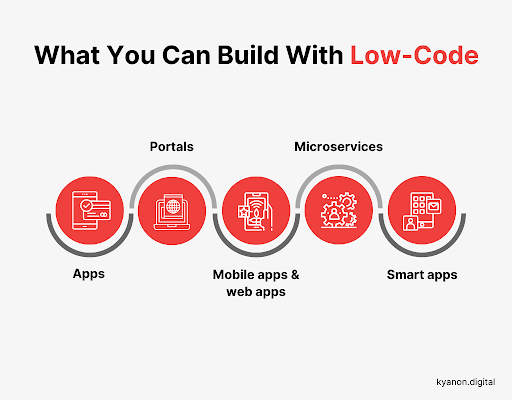New Tips On Deciding On Legacy application modernization with Low-code
Wiki Article
Benefits Of Low-Code Application Development In The Area Of Speed
Visual Development Environment :
Drag-and-Drop Interfaces: Low-code platforms provide visual tools for designing applications. Developers can use drag-and-drop components to build applications quickly without writing extensive code.
Pre-built Templates and Components A number of low-code platforms include pre-built templates and components, that allow developers to quickly develop and test applications without the need to begin from the beginning.
Coding Requirements Reduced
Automated Generated Code: Lowcode platforms generate the underlying code, based on the visual models developed by developers. This eliminates the need for manual code coding.
Reusable Parts Developers will be able reuse reusable parts across their projects, thereby reducing the time needed for writing and testing of code.
A more efficient collaboration
Integrated Development Tools: Low-code platforms usually contain tools for managing versions, testing, and deployment that allow seamless collaboration between development teams.
Citizen Development: Users of businesses as well as non-developers can contribute to application development by using intuitive interfaces, reducing the bottleneck that is often caused by the limited accessibility of professionals.
Rapid prototyping and rapid iteration
Rapid Prototyping Developers are able to quickly build prototypes for ideas to be evaluated and feedback to be gathered which results in faster iteration.
Easy Modifications. Low-code development's visual nature allows users to update and modify their apps.
Pre-built Integrations:
API Integrations. Many low-code platforms include connectors that are designed to work with the most popular APIs and other services. This could reduce the time to integrate systems.
Data Integration: The instruments that are built into the software simplify and accelerate the process of connecting databases, applications and data sources.
The deployment of scaling:
Many low-code platforms provide an option to deploy applications in one click that reduces the time and effort required to install applications.
Cloud-based solutions: Cloud-based low-code platforms can manage scaling and infrastructure management which allows developers to concentrate on the logic of their applications and functions instead of the logistics of deployment.
Overall, low-code development has advantages in terms of speed due to its ability of automatizing and simplifying a variety of elements of development. This allows faster app delivery and a simpler adaptation to changing needs. See the best helpful resource about Low-code Platform for application development for more tips including developing mobile apps, paas service, no code platforms, application modernisation, low code development platforms, multiplatform mobile app development, develop web app, cloud software applications, cross platform app development, develop mobile application and more.

The Cost-Effectiveness Of Low-Code Development Is One Of The Primary Benefits.
Low-code application development has numerous advantages when it comes to cost-efficiency which makes it a desirable alternative for companies seeking to reduce their development costs while still delivering top-quality software. The main benefits are: Reduced development costs:
Fewer Coding Requirements: Low codes platforms remove the need for extensive hand-coded, custom-built applications. Developers are able to spend less time and effort building apps. This translates to less labor costs.
We require fewer developers: Development that is low-code requires shorter time, and it is easier. This means less developers are needed. This could dramatically reduce the cost of hiring and staffing.
More Time to Market
Accelerated Development: Low-code platforms include visual development tools, pre-built components and other features that enable rapid development of applications. Businesses can bring their products on the market more quickly. This will result in more rapid growth in revenue and enhance the competitive position of their products.
Rapid prototyping allows businesses to build prototypes and test them within a short period of time, which decreases the amount of time required for the development phase. This allows them to make faster prototypes after receiving feedback from users.
Lower Maintenance Costs:
Simpler Maintenance: Low-code platforms with their modular design and components that are standardised, are easier to maintain. This helps reduce maintenance and support costs.
Automated Updates. Many low-code platforms manage patches and updates automatically. Applications are secure and safe without requiring a lot of manual input.
Efficient Resource Utilization:
Low-code platforms empower business users and other non-developers to participate in the development process. This makes it possible for companies to benefit from the expertise of a broad spectrum of employees.
Utilizing IT resources efficiently IT departments are given the chance to concentrate on more strategic initiatives, instead of getting bogged down with simple development tasks. Overall productivity and efficiency improves.
Scalable Pricing Models
Subscription-Based Price: Many low code platforms offer flexible subscription-based pricing that scales according to use. This lets businesses align their spending with the actual requirements and growth, avoiding large initial cost.
Pay-Ass-You Go Options: Some platforms offer pay-as-you-go options that guarantee that businesses only pay for the time they make use of resources. This is particularly helpful for startups and smaller businesses with a limited budget.
Reduced Third-Party Costs for Software:
Built-in Functionalities: Low code platforms have a variety of built-in functions and integrations, which eliminate the need for third-party tools and software. The cost of subscriptions and licensing fees are also reduced.
Pre-Built Integrations: Availability of pre-built integrations for popular systems and services reduces the requirement for custom development, saving both time and money.
Improved ROI:
Increased Return On Investment Rapid development and lower costs with a faster time to marketing allows businesses to get a higher return on investment.
Increased Ability. Businesses are able to quickly adjust to the demands of customers and market trends to ensure they are relevant. They can also take advantage of new business opportunities as they come up.
Lower Training Costs:
User-Friendly Interfaces: Low-code platforms provide intuitive and simple-to-use interfaces, which decreases the learning curve.
Accessible resources Low-code platforms often have comprehensive tutorials, training materials, and community assistance which reduces the need for formal training.
Collaboration can be streamlined.
Collaboration Tools: Integrated collaboration tools enhance communication and coordination between teams, which results in more efficient processes for development and reduced costs.
Unified Development Environment (UDE): An unified, single development environment that streamlines workflows, reducing costs and complexity associated with managing multiple platforms and tools.
Overall, the cost effectiveness of low-code software development can be attributed to its capability to cut down on the cost of maintenance and development and increase time to market as well as optimize the use of resources and also provide flexible pricing models. These elements provide substantial financial benefits to business, making low code a compelling option for organizations looking to maximize their budgets while delivering quality, robust, and scalable apps. Have a look at the top Legacy application modernization with Low-code hints for blog recommendations including mobile app development platforms, driver jdbc, rapid action development, azure sql server, application modernisation, app dev platform, low code development platforms, app platforms, develop mobile application, rapid application design and more.

Low-Code App Development Has Numerous Advantages When It Comes To Collaboration And Workflow
Low-code app development is an excellent option for companies looking to increase team efficiency by streamlining development processes. Here are a few advantages.
Unified Development Environment : Low-code platforms provide a single, unified environment in which all team members can collaborate effectively such as designers, business analysts and other stakeholders. They remove silos while encouraging better communication.
Visual Development Tools Low-code platforms are straightforward to use and feature an interface that allows drag-and-drop. This lets non-technical members of the team to take part during the development process, which ensures that business requirements can be captured accurately.
Enhanced Communication
Real-Time Collaboration Many low-code platforms include real-time features, such as commenting and editing simultaneously, or instant feedback. This enables continuous communication, and helps to reduce the time that is spent in back-and forth discussions.
Shared Workspaces Teams are able to work together using shared workspaces. These workspaces allow them to edit, view, discuss and collaborate on elements of the project.
Streamlined Workflow Management:
Built-in Project Management Tools: Low-code platforms typically include integrated tools for managing projects that help teams plan and track their development projects. This includes the assigning of tasks, tracking progress, and managing deadlines.
Workflow Automation: Automation of repetitive tasks and workflows can reduce the manual effort and mistakes which allows teams to concentrate on more strategic work and enhancing overall efficiency.
Faster Iteration cycles
Rapid prototyping: Low code platforms permit rapid prototyping rapid development, iterative development, and prototyping, which allows teams to create applications, test them and refine them in shorter cycles. This allows feedback to be quickly incorporated and improvements implemented quickly.
Agile Development Support : Support of agile practices allows team members to work on sprints. They can continue to deliver small increments in functionality, and easily adapt to changes in requirements.
Accessibility for those who are not developers
Citizen Development: Low code platforms allow business users (citizens developers) to build and modify applications, with no extensive knowledge of coding. This relieves IT and development teams of the burden and allows quicker responses to business needs.
Onboarding and training: The intuitive user interfaces and extensive training materials help bring new members of the team up to the speed of learning. This improves the overall collaboration in the team.
Centralized documentation, knowledge sharing and dissemination:
Documentation is integrated into low code platforms usually come with features to create and maintain documentation on the platform, making it simple to allow all project data to be centralized.
Knowledge Repositories: Teams can create and keep knowledge repositories, which include the best practices, templates and reuseable components, helping to facilitate knowledge sharing and reducing duplicate work.
Consistency in Standardization:
Standardized components: Standardized, pre-built component ensures uniformity in applications. Team members can comprehend and work with greater ease on various parts.
Governance and Compliance: Integrated into governance frameworks that ensure that every development follows organization standards and regulations, minimizing risk of non-compliance and ensuring that applications meet high quality standards.
Feedback and Improvement
Integrated Feedback Mechanisms Low-code platforms typically have integrated feedback mechanisms that allow users to easily provide feedback to applications. This can then be incorporated into the process of development.
Continuous Improvement: The ability of rapidly implementing changes based on feedback will ensure that the software is continuously developed, while being in tune with the goals and needs of users.
Visualization, Reporting and Analyzing:
Real-time Analytics: In-built analytics and reporting provide real-time information about the project's performance, user interaction and progress. Data-driven decision-making is feasible.
Visual Workflow Analysis: Visual tools are used to visualize workflows and processes. These tools assist teams analyze and improve their workflows.
The main benefits of low-code application development in terms of collaboration and workflow lie in its capacity to bring together diverse teams as well as streamline communication and automate processes. This results in a more cooperative and productive development environment, ultimately leading to better-performing applications and greater alignment with business objectives.
